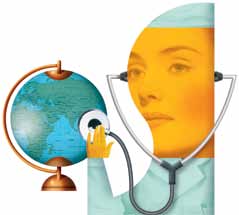The Global Challenge of Improving Population Health
Faculty Essay by John P. Allegrante
In this age of costly, high-tech medicine, we sometimes forget that health promotion and disease prevention remain the keys to improving the health status of entire populations. The benefits of preventive care—along with good genes—are readily apparent in societies like Iceland
Less apparent is the foundation underlying such achievements—the widespread childhood immunization campaigns, the state-of-the-art environmental sanitation, and the investment in public health infrastructure and education to discourage smoking, promote physical activity and improve diet.
More broadly, such societies recognize that five factors determine population health: genetics, social circumstances, environmental exposures, behavioral patterns and lifestyle, and the provision of basic medical and rehabilitation care. Their leaders maximize those factors by ensuring that schools and workplaces are equipped to attend to the physical, psychological and social health problems of students and employees, and by supporting a new breed of health professional in fostering optimal human development across the life span. One example of this approach is “The Icelandic Model,” which has dramatically reduced teen smoking, drinking and substance use by positioning schools and sports clubs at the center of community-wide efforts to bring parents into closer contact with their children.
Further still, the most enlightened societies understand that “prevention” entails addressing all determinants of human well-being, from providing employment that gives people dignity, to protecting and preserving natural resources, to educating young people not only for intellectual excellence but also for autonomy and civil society.
“Public health,” then, is something far greater than a profession, a field or even a term that describes the physical and mental status of human beings. It refers to the living fabric of a society—something in which we all very clearly have a stake.
~~~
John P. Allegrante is Professor of Health and Education at Teachers College and Chair of the Department of Health and Behavior Studies.
Published Monday, Jun. 15, 2009
